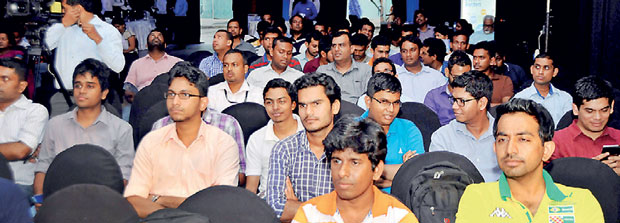29 Dec 2016 - {{hitsCtrl.values.hits}}


Sri Lanka Telecom together with SLASSCOM recently presented one of the globally emerging topics of Cloud-based ‘Microservices Architecture’ through a knowledge sharing programme themed, ‘TechTalk’.
The programme was successfully held at the Trace Expert City, Maradana with the participation of a large number of software/application developers and coding experts in Sri Lanka.
This much talked about Cloud based Micro services Architecture (PaaS or Platform-as-a-Service) promises greater developer agility, significant cost savings and expedited time to launch applications in the market.
The Director of Architecture at WSO2 Inc, Afkham Azeez, the Head of Development of Ascension IT, Janaka Wickramasinghe and Ashan Fernando, the AWS Solution Architect at 99X Technology were the resource persons who made presentations on the topics, ‘Microservices Theory’, ‘Containerized Infrastructure - Kubernetes/Docker case study & live demo on SLT Akaza Cloud platform’ and ‘Microservices without servers’ respectively, followed by a Q&A Session.
Addressing the audience, Kiththi Perera, Group Chief Enterprise and Wholesale Officer of SLT said, “We are investing further in our broadband and cloud infrastructure. We are extending our fibre broadband network and broadening our cloud portfolio enabling more options. We have established a breakthrough cloud platform locally – which, even though is not different from the global platforms will certainly deliver domestic bandwidth advantage.”
Many global giants who provide Internet based services have solved the complexities of the systems and platforms by adopting the Microservices architecture pattern. Instead of building a single monstrous, monolithic application, the idea is to split the application into a set of smaller, interconnected services. A service typically implements a set of distinct features or functionality, such as order management, customer management, inventory control etc. Each Microservice is a mini-application that has its own hexagonal architecture consisting of business logic along with various adapters. Some Microservices would expose an Access Point Integrator (API) which is consumed by other Microservices or by the application’s clients. Other Microservices might implement a web User Interface (UI). At runtime, each instance is often a cloud Virtual Machine (VM) or a docker container.
The future of global data services relies mostly on the integration of Microservices, APIs, and Platforms. Only through a successful integration can companies and operators bring the availability of their data to new heights and help make it possible for anyone, anywhere to gain access to information they never had before. Integration services and APIs are specifically powering the growth of Mobile and Internet of Things (IoT) and helping people and organizations solve problems that would have been impossible a few years ago.
On a global scale, the adoption of Microservices by the developer community has skyrocketed within a short period, though they are still not used everywhere. As more and more businesses are moving towards Microservices, it is imperative for developers to educate themselves on modular architectures, container solutions such as Docker, and container management tools such as Kubernetes.
09 Jan 2025 23 minute ago
09 Jan 2025 55 minute ago
09 Jan 2025 1 hours ago
09 Jan 2025 1 hours ago
09 Jan 2025 1 hours ago